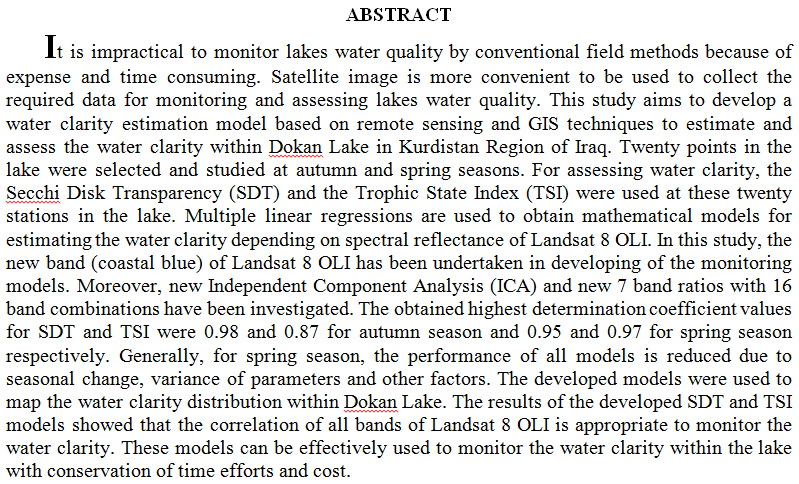
 (5)
(5)
 (11)
(11)
 (8)
(8)
English
DEMs, thus, simply regular grids of elevation measurements over the land surface.The aim of the present work is to produce high resolution DEM for certain investigated region (i.e. Baghdad University Campus\ college of science). The easting and northing of 90 locations, including the ground-base and buildings of the studied area, have been obtained by field survey using global positioning system (GPS). The image of the investigated area has been extracted from Quick-Bird satellite sensor (with spatial resolution of 0.6 m). It has been geo-referenced and rectified using 1st order polynomial transformation. many interpolation methods have been used to estimate the elevation such as ordinary Kriging, inverse distance weight
... Show MoreFive heavy metals, namely Cd, Cu, Fe, Mn, and Pb in the surface water and through the water column were studied at 10 selected stations in the Razzazah lake and Karbala drainage canal for the period between November 1990 to October 1991*. pH and total hardness were also measured. Lead was found to be the highest in concentration as overall average values, followed by an manganese, iron, copper then cadmium at the surface as well as along the water column. All the studied metals were below or close to the maximum allowed limits of Iraqi standards for inland water. The spatial and seasonal variations were discussed.
In the current paradigms of information technology, cloud computing is the most essential kind of computer service. It satisfies the need for high-volume customers, flexible computing capabilities for a range of applications like as database archiving and business analytics, and the requirement for extra computer resources to provide a financial value for cloud providers. The purpose of this investigation is to assess the viability of doing data audits remotely inside a cloud computing setting. There includes discussion of the theory behind cloud computing and distributed storage systems, as well as the method of remote data auditing. In this research, it is mentioned to safeguard the data that is outsourced and stored in cloud serv
... Show MoreThin films of iridium doped indium oxide (In2O3:Eu)with different doping ratio(0,3,5,7,and 9%) are prepared on glass and single crystal silicon wafer substrates using spray pyrolysis method. The goal of this research is to investigate the effect of doping ratio on of the structural, optical and sensing properties . The structure of the prepared thin films was characterized at room temperature using X-ray diffraction. The results showed that all the undoped and doped (In2O3:Eu)samples are polycrystalline in structure and nearly stoichiometric. UV-visible spectrophotometer in the wavelength range (200-1100nm)was used to determine the optical energy gap and optical constants. The optical transmittance of 83% and the optical band gap of 5.2eV
... Show MoreThis work was conducted to study the extraction of eucalyptus oil from natural plants (Eucalyptus camaldulensis leaves) using water distillation method by Clevenger apparatus. The effects of main operating parameters were studied: time to reach equilibrium, temperature (70 to100°C), solvent to solid ratio (4:1 to 8:1 (v/w)), agitation speed (0 to 900 rpm), and particle size (0.5 to 2.5 cm) of the fresh leaves, to find the best processing conditions for achieving maximum oil yield. The results showed that the agitation speed of 900 rpm, temperature 100° C, with solvent to solid ratio 5:1 (v/w) of particle size 0.5 cm for 160 minute give the highest percentage of oil (46.25 wt.%). The extracted oil was examined by HPLC.
Basrah is the richest town and the economic capital of Iraq. It suffers from lack of drinking water. This project is a dream to supply drinking water to Basrah citizens within WHO standards. Water should pass sedimentation and filtration stages before interring reverse osmosis unit. The design is carried out using lewaplus2 software. Several parameters should be selected in the design step membrane type, number of stages, number per element in each stage, and the recovery percentage. An optimization is carried out using Minitab ver. 18 for the acceptable limit of TDS and minimum cost and it was found that the optimum conditions were 52% for first stage, the numbers of vessels are 20 for both the first and second stage. In addition,
... Show More